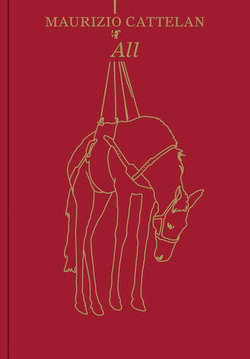Читать книгу Maurizio Cattelan: All - Maurizio Cattelan - Страница 6
На сайте Литреса книга снята с продажи.
Оглавлениеfig. 1 Untitled, 2001
prologue
WHAT artists read is often a good indication of what they are thinking, if not their sources of inspiration. A well-stocked bookshelf in the corner of a studio can be as revealing as any explication of a specific work in progress. This rings especially true for Maurizio Cattelan, who rarely divulges his intentions, preferring instead to hide behind a perfectly crafted persona of class clown or inveterate juvenile delinquent. His selections for the Artist’s Choice section of the first comprehensive monograph on his work, published in 2000, are, therefore, especially valuable clues.1 With an exceptionally salacious excerpt from Portnoy’s Complaint, Philip Roth’s brilliant caricature of male Jewish-American angst, followed by extracts from a book of collected suicide notes, Cattelan obliquely conveys the key motivating impulses behind his practice: desperation and guilt.2 After failing, Cattelan claims, at all prior pursuits from the academic to the professional, he approached the art world as a kind of refuge, a place where he could rehearse his anxieties publicly and be rewarded for doing so. Like Alexander Portnoy in Roth’s novel, Cattelan is perpetually searching for an escape from himself, his past, and all rules imposed on him. The long-suffering Portnoy turned to psychoanalysis to overcome the suffocating embrace of his overprotective parents and to understand if not absolve his untoward desires. For Cattelan, the art world is the analyst’s couch. Since the beginnings of his career as an artist during the late 1980s, he has freely enacted his vulnerabilities, giving them physical form and a distinct narrative, one that, in many ways, has come to define his work as a whole.
But this is only one side of the story. Cattelan’s compelling performance of his own psychopathology is less autobiographical in origin than it is a poetic gesture toward universality. By playing the (neurotic) fool, he offers himself up as an Everyman, suggesting that this archetypal figure is ultimately more fragile than appearances may allow. By pursuing his work as a kind of expiation, Cattelan problematizes the image of the male artist as virile generator of creative form, joining a long line of twentieth-century forerunners including Marcel Duchamp, Andy Warhol, and Richard Prince, to cite a few figures who play more than passing roles in the artist’s intellectual development. This art-historical trinity embodies the avant-garde’s (and the neo-avant-garde’s) turn to popular culture as both source and medium in modernism’s ongoing flirtation with the dissolution of difference between art and life. What connects Duchamp’s readymades with Warhol’s soup cans and Prince’s appropriated jokes is a critical, defining shift from production to selection, which indicates a certain devaluation of the artist’s hand. The skillfully crafted object bearing the marks of individual intervention was no longer considered the exclusive manifestation of artistic genius. In fact, the very notion of artistic genius—associated in the early to mid-twentieth century with transcendent aesthetic vision and the expression of inner or otherwise invisible truths—has been under sustained interrogation, with Duchamp’s Dadaesque dismissal of opticality, Warhol’s laconic, mechanical detachment, and Prince’s self-denigrating, appropriated humor. For Cattelan, who has portrayed himself as a chronic underachiever, the antiheroic stance of these artists provided tactical prototypes. In an interview from 1999, already well established in his career, he went so far as to declare, “I am not an artist,” and “I make art, but it’s a job.” He explained, “I fell into this by chance. Someone once told me that it was a very profitable profession, that you could travel a lot and meet a lot of girls. But this is all false; there is no money, no travel, no girls. Only work. I don’t really mind it, however. In fact, I can’t imagine any other option. There is, at least, a certain amount of respect. This is one profession in which I can be a little bit stupid, and people will say, ‘Oh, you are so stupid; thank you, thank you for being so stupid.’”3
NOTES
Unless otherwise noted, unattributed quotations by Maurizio Cattelan are from a series of interviews with the author on July 7 and 9, 2010, and e-mail exchanges in March and April 2011.
1 This book was published as part of Phaidon Press’s highly visible monograph series, which focuses on midcareer contemporary artists. Each book follows a strict format comprising a main essay, an interview with the artist, a brief text focusing on one of his or her works, a selection of the artist’s own writings, and excerpted readings of his or her choice. See Maurizio Cattelan (London: Phaidon Press, 2000; rev. ed. 2003). All citations refer to the 2003 edition.
2 Artist’s Choice, Maurizio Cattelan (2003), pp. 100–109. The original sources are Philip Roth, Portnoy’s Complaint (New York: Random House, 1969) and Marc Etkind, . . . Or Not to Be: A Collection of Suicide Notes (New York: Riverhead, 1997).
3 From “Nancy Spector in Conversation with Maurizio Cattelan,” in Maurizio Cattelan (2003), p. 9.
